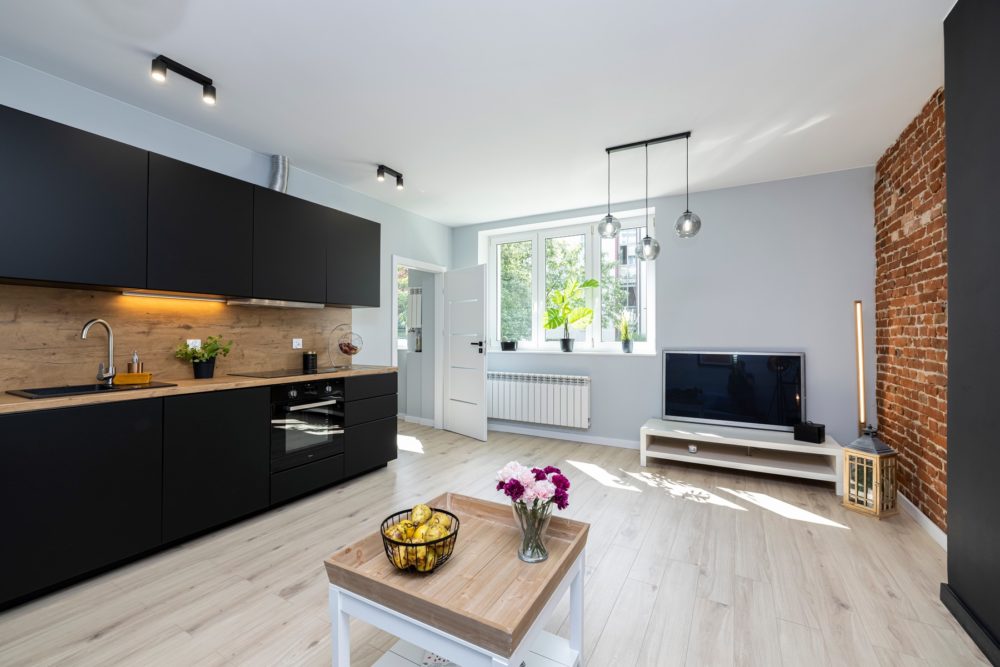When planning to furnish a flat, it is definitely worth doing some research on the finishing market, and it is best to go to an architectural office which will help us draw up a design and choose materials that fit within our budget. However, before you get down to discussing the details with your designer, you need to make a basic choice and decide what style you are finishing the property in. There are many possibilities, so it is worthwhile not only to follow your own taste, but also to rely on the advice of an experienced architect.
Minimalist or luxurious?
The basic issue is aesthetics and functionality – depending on our preferences, we can opt for a minimalist or ornate style. Nowadays, a frugal aesthetic definitely dominates the market and maximalism is considered an outdated style. This does not mean, however, that it is abandoned altogether – many people choose to introduce additional solutions because they find minimalism too austere and therefore cold. When someone prefers cosy interiors, but at the same time does not want to escape too much from modernity, eclecticism, which consists of mixing different styles, can be a perfect compromise. If, on the other hand, you dream of vibrant interiors full of planned chaos, it’s worth letting your imagination run wild and going for maximalism. Multi-coloured spaces filled with lots of little things don’t have to be overwhelming or overdone. Most often they will give the interior a unique character and more intimacy. On the other hand, the minimalist variant is synonymous with composure, order and a certain distance.
Consultation with an architect
Basically, you can find a lot of sample space arrangements in catalogues, each of which undoubtedly looks great and certainly tempts all viewers. However, life is not a catalogue, so in making a decision we should be guided not only by aesthetic impressions, but also by the functionality of a given solution. In the vast majority of cases, we won’t even be able to anticipate certain technical issues, so the best idea would be to consult a professional interior decorator. Even a short research, during which a customer presents his expectations and the designer asks about the details, allows a lot of valuable information to be obtained about the – very often unconscious – preferences of the customer. This is a great opportunity to decide on a particular style, as the technical notes can provide an ideal guide for a designer preparing the design, his advice can in turn help dispel some of the buyer’s doubts.
Matching the possibilities
An extremely important issue is the ability to match the style to the possibilities of the premises, because although in the catalogue each solution may look really great, the reality may quickly verify our plans. In order to avoid any misunderstandings, it is also worth going to a specialist, as trying to furnish your flat on your own may end in failure. The thing is, the style has to be adapted to the size of the premises. For example, minimalism will work perfectly in a cramped flat, optically enlarging the space. Scandinavian, modern or industrial styles are therefore recommended for small spaces. On the other hand, classic, rustic, glamour or Art Deco styles will work perfectly in a larger space. Of course, these are only suggestions, and for more details it is definitely worth going to a design office, where after a short interview it will be much easier to decide on the ideal solution tailored not only to your tastes, but also to your possibilities.
Finally, it is worth mentioning that ideal solutions do not really exist, so there is no need to set your mind on finding “the only one”. Instead of insisting on making another attempt to realise an impossible dream, it is definitely better to experiment, try out different styles and you are bound to find something that is an excellent compromise. And don’t forget that you can make some changes to the interior design from time to time, so no decision really has to be final.


